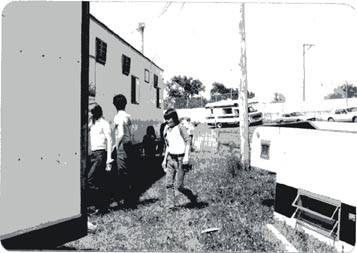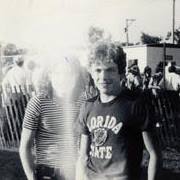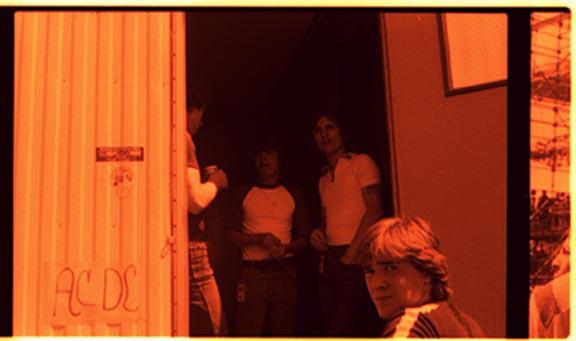By J.J. Tindall
I vividly recall the first time I heard AC/DC.
It was 1978, and I was waiting in line at the Tilt-a-Whirl at the Last Fling Carnival, a Naperville Labor Day weekend tradition. The carnies were classic biker types, taking tickets, running the rides and cranking music out of an eight-track player lined through huge, heavy bass-end speaker cabinets.
I was 17, a “classic rock” fan just getting into new wave – a typical example of one who had older brothers who were into the original great bands of the ’60s (with the notable exception of The Who). I was a diehard Stones fan, loved guitar bands, and as I waited in line that night for the Tilt, I became acutely self-aware: my ass was being kicked (cue Artie Fufkin).
My ears, my soul and my ass honed in on this intense, two-guitar groove, tight as I’ve ever heard, pulsing steady, square in the pocket. The singer’s voice was that of an acid crocodile, utterly unique. But it was the guitars that had me transfixed. It wasn’t heavy metal, it was hard rock. “That sounds like the Stones!” I thought to myself. It was extraordinarily hypnotic. I asked the carnie what it was.
“AC/DC. Powerage.”
And I was on it.
That album, produced by Harry Vanda and George Young, the oldest of the Young brothers, had a direct (some American critics said rough), solid sound, perfectly lacking in extras, nothing to get between the instruments and the ear.
I simply could not get enough of the intricate interplay between guitarists Malcolm and Angus Young. I compare it to the interplay between Keith Richards and Brian Jones (compare their live “Route 66” to AC/DC’s live “Bad Boy Boogie;” Richards, himself a keen AC/DC fan, still cites Powerage as his personal favorite).
The bass playing was simplistic but absolutely appropriate for the style. The idiosyncrasies of Bill Wyman or the voluptuousness of John Entwistle would have been wrong, like Keith Moon playing for the Beatles. Bon Scott had a voice like no other. I did not concern myself too much with the lyrics (from clever to crass to offensive in a single bound).
And so began my journey. I had to turn my friends onto this stuff.
The next album, Highway to Hell, was produced by Mutt Lange and had a brighter, more polished overall sound, but the basic boogie remained intact. That album became a party staple, along with standard Beatles/Stones/Who (I found them through peers) but also Tom Petty, Bob Seger, REO, the Clash, Fleetwood Mac, Talking Heads. My friends and I got into the habit of not only bringing albums to parties but also the stereo system itself, the better to control the set list. I made sure Highway to Hell got into heavy rotation.
In 1979, AC/DC were on a bill with Cheap Trick, the Babys, Molly Hatchet and Steve Dahl & Teenage Radiation at the Rockford Fairgrounds for the Fourth of July. As kismet would have it, one of our classmates had an “in” with the promoters: they were looking for kids to serve at the concession stands and if you were willing to work a few hours, you could get backstage.
And we were on it!
At the time, I was trying to get to any concert of interest that I could get to, and would often bring along my mother’s 35mm camera. I had tons of enthusiasm and absolutely no skill with the thing, but enthusiasm turned out to be enough.
I was maybe a half-hour into slinging Cokes in the ramshackle hut they’d set up for “concessions” when AC/DC took the stage. Once again, it was like nothing I’d ever heard before. The power, the groove, the attack quite literally overwhelming. I said “FUCK this!” and snuck out the back of the hut, camera around my neck, and went out into the general admission area in front of the stage.
Behold! Angus Young and band, tearing the place to shreds. In the now-classic schoolboy outfit and the now classic head-banging thrust of neck and hair, he was all over the place. At one point, he disappeared, only to re-appear atop the 50-foot speaker stack at stage left. I think of the phrase “whirling dervish.”
But that was only possible because of stoic Malcolm, holding down the fort, shaping the riffs, directing without directing, an anchor. No anchor, no dervish. Angus got the attention but Malcolm did most of the heavy lifting. And I’ve always favored “rhythm” guitarists: Chuck Berry, John Lennon, Jimmie Vaughan. Malcolm defined the type: Riff Master.
With my “Concession” T-shirt I was able to get backstage after their set, hell-bent on getting some pictures. The backstage vibe was a little strange: Cheap Trick, specifically, had roadies telling me and mine that No Pictures were allowed. From afar, I took one anyway, and you could see Rick Nielsen in full regalia, the visually outstanding Tricker the way Angus was the visual hook to AC/DC. The Babys were dandies, wafer-thin, the most clearly “rock star” dressed of the bunch, and even now I wouldn’t know a Molly from a Hatchet.
The vibe around AC/DC’s trailer was decidedly different. To say they “dressed down” would be an understatement. Only Angus had to change out of stage clothes. Nobody gave a damn if I took pictures or not. At one point, I saw Phil Rudd and Malcolm Young walk by and I felt comfortable enough to snap a few shots.

Then I asked Malcolm: “Can I get a shot of Angus?” He casually pointed right behind me and as I turned, ladies and gentleman, Angus Young!

I put the camera to my face, aimed it at him a few feet away, and he gave me a classic Stones Tongue gape. He stopped, and we had a bit of a chat. “Man, you really sweat it out on stage,” I said stupidly, as one does in these cases. “Yeah, man, I drink a lot of tea before.” Relaxed, unassuming, no airs, just another cool dude.
I asked if my buddy could take a picture of us together. “No problem.”

That was more than enough and I didn’t want to bother him more so we moved on.
I got another shot into their trailer, Bon, Mal and Phil.

That was my first backstage experience, and by far the most relaxed of them all. Most of the other times, with notable exceptions (the Stones ’07, in fact, believe it or not), security created a hostile vibe.
AC/DC came to the Aragon Ballroom in the fall, and we drove up from Illinois State to be there. Once again, no special effects, no giant octopi or small second stage, just the band and us freaks. It was the last show I would see with Bon Scott; he died a few months later.
Then we get Brian Johnson, Back in Black and they become superstars. Black, again produced by Mutt Lange, added a true third dimension to their guitar sound (a sound into which they essentially locked from then on). It was definitely in heavy rotation in Watterson Towers at ISU, and when AC/DC came there to play at Braden Auditorium, we got sixth-row seats. My ears literally rang for days.
Back in Black’s “Rock & Roll Ain’t Noise Pollution” says it all about what a refined touch Malcolm had: taste, time and chime. Thick riffs, hard breaks, slow but swinging. It’s got to swing, and that was, to me, one of Malcolm’s signature gifts.
After the next album, For Those About to Rock We Salute You, I sort of lost the plot, let it go, until their recent resurgence before Malcolm’s dementia diagnosis.
Over time, with the help of Google and YouTube, one comes to find that Malcolm may have seemed quiet, but he wasn’t. He ran the show, in effect. Once, when challenged by an interviewer who suggested that after Back in Black, they made 12 more versions of that album, Malcolm wasn’t having it: “THIRTEEN, mate!”
Now that Malcolm has passed, I think of that first encounter with the Monster Groove, that low-key, fan-friendly backstage atmosphere allowing me to get some great bad photos, and those riffs, man – solid, sure, steady through time. I mean to salute a true master.
–
Previous Fan Notes:
* Fan Note: Confessions Of A Radiohead-Head
* Fan Note: Shawn Phillips Is The Man.
* Fan Note: Me & Metallica.
–
Submit your own Fan Note.
Posted on November 21, 2017


